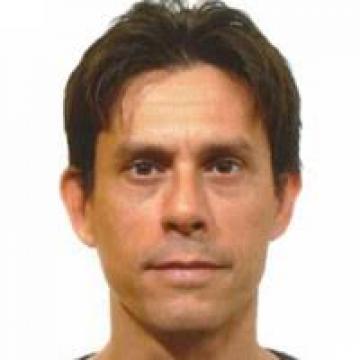prof. Kevin Braeckmans (PhD)

Full professor (faculty of Pharmaceutical Sciences, UGent)
Principal investigator and co-director – Lab. General Biochemistry and Physical Pharmacy (UGent)
Group leader - Biophotonics Research Group (UGent)
Chairman and member of Ghent Light Microscopy (GLiM) CORE (UGent)
Member of BIOMARKED Steering Committee
Research focus
Research of the Biophotonics Research Group is structured along three major themes:
investigating the interaction of nanomedicines with biological barriers, in which advanced light microscopy techniques play a crucial role
optics-based biomedical diagnostics
light-triggered delivery of functional compounds into cells and other tissues
Several of our projects link to cancer research, e.g. optical fingerprinting of cancer-related extracellular vesicles from liquid biopsies and safe engineering of therapeutic cells (e.g. T-cells) with optical technologies. More information can be found on this group’s webpage .
Expertise to offer
Expertise Ghent Light Microscopy (GLiM) CORE: The microscopy centre aims to provide high end instrumentation and expertise thereby making light microscopy accessible for researches independently of their experience level. The centre facilitates microscopy experiments to ensure high-quality scientific research where light microscopy plays an indispensable role.
Read moreExpertise on transfecting cells in vitro and ex vivo.
Biography
Having obtained a Licentiate degree in Physics at Ghent University (Belgium) in 1999, Kevin Braeckmans joined the Laboratory of General Biochemistry and Physical Pharmacy (Ghent University) to perform research on advanced optical microscopy methods for pharmaceutical applications. During his Ph.D. he was involved in the development of a new type of encoded microcarriers for diagnostic applications, for which he received the first price for Young Biotechnology Researchers from the Funds of Biotechnology (FBBF, Belgium) in 2005. In 2004 he received a post-doctoral fellowship from the Fund for Scientific Research – Flanders, focusing on single particle tracking microscopy, during which time he was a visiting postdoctoral at the Christophe Bräuchle lab, Physikalische Chemie I, Ludwich Maximilians University Munich.
In 2008 he was appointed as professor at Ghent University where he is currently leading the Bio-Photonics Research Group in close collaboration with the Ghent Research Group on Nanomedicines (prof. Stefaan De Smedt, prof. Katrien Remaut, prof. Koen Raemdonck & prof. Félix Sauvage). From 2015-2020 he held a position as Guest Professor at the University of Lille (France), and became a full professor at Ghent University in 2018. A first line of research involves the study of biological barriers of functional nanomaterials by advanced microscopy techniques. Apart from that there is also an interest in developing optics based methods for medical diagnostics. A recent important research field in the group is the usage of light as mediator for nanoparticle and drug delivery. This work was funded by a prestegious ERC Consolidator Grant (NANOBUBBLE, 2015-2020) and an ERC Proof of Concept Grant (INTRACYTE, 2021-2022). In 2021 he co-founded the spin-off company Trince to bring related technology for safe engineering of cells (e.g. CAR T cells) to the market.
Research team
The Biophotonics Research Group is a multidisciplinary team of about 10 PhD students and post-doctoral researchers. An up to date overview can be found per research topic on this web page.
Cancer researchers :
dr. Wenjia Xie (PhD) - post-doctoral fellow
Chloë De Clercq - doctoral fellow
Amin Ahmad - doctoral fellow
- Baihao Huang - doctoral fellow
- Léo Baland - doctoral fellow
Key publications
- Precisely and accurately localizing single emitters in fluorescence microscopy. Nature Methods 11, 253-266 (2014).
- Identification of Individual Exosome-Like Vesicles by Surface Enhanced Raman Spectroscopy. Small 12, 3292-3301 (2016).
- Sizing nanomaterials in bio-fluids by cFRAP enables protein aggregation measurements and diagnosis of bio-barrier permeability. Nat. Comm. 7, Article Number 12982 (2016).
- Laser-Induced Vapour Nanobubbles Improve Drug Diffusion and Efficiency in Bacterial Biofilms. Nature Communications 9, Article Number 4518 (2018).
- Photoporation with biodegradable polydopamine nanosensitizers enables safe and efficient delivery of mRNA in human T cells. Adv. Funct. Mater. 33, Art. 2102472 (2021).
- Photothermal nanofibers enable safe engineering of therapeutic cells. Nat. Nanotechnol. 16, 1281-1291 (2021).
- Light-Triggered Nanobombs: Nanoscale Biolistics for Efficient Intracellular Delivery of Functional Macromolecules in Mammalian Cells. Nat. Comm. 13, Art nr. 1996 (2022).
- Delivery of macromolecules in unstimulated T cells by photoporation with polydopamine nanoparticles. J. Control. Release 354, 680-693 (2023).
- Laser-induced vapor nanobubbles for B16-F10 melanoma cell killing and intracellular delivery of chemotherapeutics. J. Control. Release 365, 1019-1036 (2023).
- Non-viral delivery of RNA for therapeutic T cell engineering. Adv. Drug Deliv. Rev. 208, 115215 (2024).
Contact & links
- Lab address : Lab. General Biochemistry & Physical Pharmacy, Faculty of Pharmaceutical Sciences, Ottergemsesteenweg 460, 9000 Gent, Belgium
- Lab. General Biochemistry and Physical Pharmacy
- Ghent Light Microscopy (GLiM) CORE
- Expertise Ghent Light Microscopy (GLiM) CORE and Bio-Photonic Research group
- Google Scholar